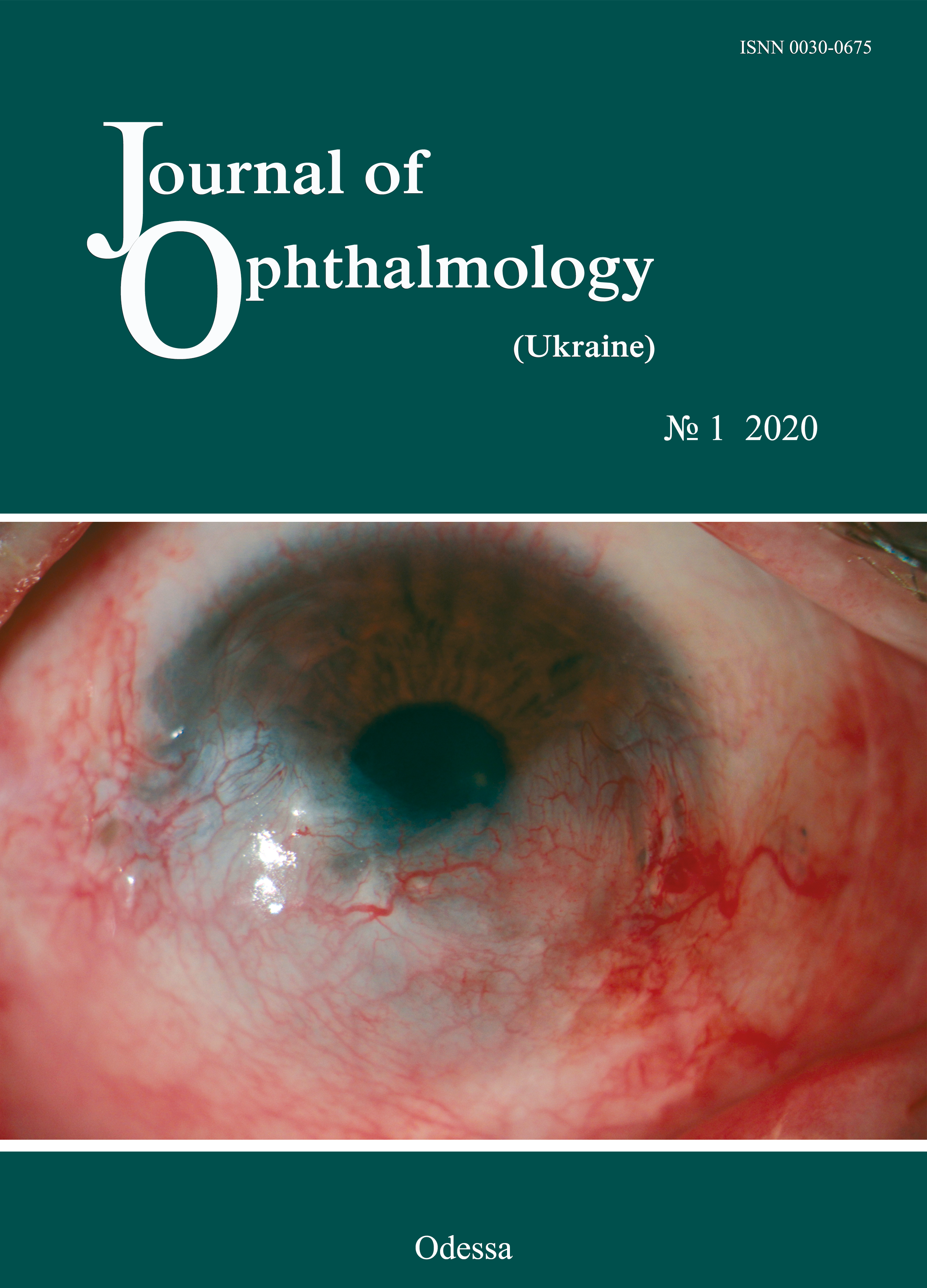Early signs of primary compressive optic atrophy evidenced by OCT in patients with basal brain tumors
DOI:
https://doi.org/10.31288/oftalmolzh202013539Keywords:
basal brain tumors, chiasmal syndrome, optic atrophy, optical coherence tomographyAbstract
Background: Compression of the optic nerve/chiasm complex is typical for patients with basal neoplasms located in the middle or anterior cranial fossae. The most common of these neoplasms are pituitary adenomas, meningiomas and craniopharyngiomas. Chiasmal compression is accompanied by a gradual decrease in visual acuity, bitemporal visual field defects and development of primary descending optic atrophy (OA). Optical coherence tomography (OCT) is a relatively new non-invasive imaging modality that allows objective assessment of stereometric parameters of the optic nerve.
Purpose: To assess OCT-measured morphostructural parameters of the retina and optic nerve in patients with primary optic atrophy due to compression by basal brain tumors (BBT).
Material and Methods: This retrospective study included the records of 43 patients (86 eyes) who received treatment for BBT at the Romodanov Institute during 2016 to 2017. Patients underwent clinical and neurological, eye, and otoneurological examination, and neuroimaging procedures, particularly OCT with a Revo NX instrument (Optopol Technology SA, Poland).
Results: The OCT features of compressive descending OA varied with the severity of chiasmal syndrome (CS). The peripapillary retinal nerve fiber layer (RNFL) thickness was statistically significantly different between patients with CS versus controls and versus patients with no CS. In addition, there was a significant difference (p < 0.05) in reduction in neuroretinal rim area in patients with CS, compared with controls. The macular ganglion cell complex (GCC) thickness was thinner in each subgroup of patients than in the control group. There were significant direct correlations of visual field mean deviation (MD) with RNFL thickness and GCC thickness.
Conclusion: OCT is a modern non-invasive objective modality that can be utilized in the diagnosis of primary OA, and allows quantifying the reduction in nerve fiber thickness. The GCC thickness analysis provides earlier diagnosis of chiasmal compression than identification of temporal visual field defects or analysis of peripapillar RNFL thickness.
References
1.Abouaf L, Vighetto A, Lebas M. Neuro-ophthalmologic exploration in non-functioning pituitary adenoma. Annals of Endocrinology. 2015 Jul;76(3):210-9. https://doi.org/10.1016/j.ando.2015.04.006
2.Predoi D, Badiu C, Alexandrescu D, Agarbiceanu C, Stangu C, Ogrezeanu I, et al. Assessment of compressive optic neuropathy in long standing pituitary macroadenomas. Acta Endocrinologica (Buc). 2008 Jan; 4(1):11-22.https://doi.org/10.4183/aeb.2008.11
3.Guk MO. [Diagnosis and comprehensive treatment of hormonally-inactive pituitary adenomas]. Thesis for Doctor of Medical Sciences. Kyiv. 2017. Ukrainian.
4.Kitthaweesin K, Ployprasith C. Ocular manifestations of suprasellar tumors. J Med Assoc Thai. 2008; 91(5):711-5.
5.Serova NK. [Clinical neuroophthalmology. Neurosurgery aspects]. Tver': Triada; 2011. Russian.
6.Frohman E, Fujimoto J, Frohman T, Calabresi P, Cutter G, Balcer L. Optical coherence tomography: a window into the mechanisms of multiple sclerosis. Nat Clin Pract Neurol. 2008 Dec;4(12):664-75. https://doi.org/10.1038/ncpneuro0950
7.Schuman J, Hee M, Arya A, Pedut-Kloizman T, Puliafito C.A, Fujimoto J.F, Swanson EA. Optical coherence tomography: a new tool for glaucoma diagnosis. Curr Opin Ophthalmol. 1995; 6:89-95.https://doi.org/10.1097/00055735-199504000-00014
8.Johansson C, Lindblom B. The role of optical coherence tomography in the detection of pituitary adenoma. 2009 Nov;87(7):776-9. https://doi.org/10.1111/j.1755-3768.2008.01344.x
9.Danesh-Meyer HV, Carroll SC, Foroozan R, Savino PJ, Fan J, Jiang Y, Vander Hoorn S. Relationship between retinal nerve fiber layer and visual field sensitivity as measured by optical coherence tomography in chiasmal compression. Invest Ophthalmol Vis Sci. 2006 Nov;47(11):4827-35.https://doi.org/10.1167/iovs.06-0327
10.Kanamori A, Nakamura M, Matsui N, et al. Optical coherence tomography detects characteristic retinal nerve fiber layer thickness corresponding to band atrophy of the optic disc. Ophthalmology. 2004 Dec;111(12):2278-83.https://doi.org/10.1016/j.ophtha.2004.05.035
11.Tieger MG, Hedges TR 3rd, Ho J, Erlich-Malona NK, Vuong LN, Athappilly GK, Mendoza-Santiesteban CE. Ganglion Cell Complex Loss in Chiasmal Compression by Brain Tumors. J Neuroophthalmol. 2017 Mar;37(1):7-12. https://doi.org/10.1097/WNO.0000000000000424
Downloads
Published
How to Cite
Issue
Section
License
Copyright (c) 2025 К. С. Єгорова, М. А. Знаменська, М. О. Гук, А. О. Мумлєв

This work is licensed under a Creative Commons Attribution 4.0 International License.
This work is licensed under a Creative Commons Attribution 4.0 International (CC BY 4.0) that allows users to read, download, copy, distribute, print, search, or link to the full texts of the articles, or use them for any other lawful purpose, without asking prior permission from the publisher or the author as long as they cite the source.
COPYRIGHT NOTICE
Authors who publish in this journal agree to the following terms:
- Authors hold copyright immediately after publication of their works and retain publishing rights without any restrictions.
- The copyright commencement date complies the publication date of the issue, where the article is included in.
DEPOSIT POLICY
- Authors are permitted and encouraged to post their work online (e.g., in institutional repositories or on their website) during the editorial process, as it can lead to productive exchanges, as well as earlier and greater citation of published work.
- Authors are able to enter into separate, additional contractual arrangements for the non-exclusive distribution of the journal's published version of the work with an acknowledgement of its initial publication in this journal.
- Post-print (post-refereeing manuscript version) and publisher's PDF-version self-archiving is allowed.
- Archiving the pre-print (pre-refereeing manuscript version) not allowed.












